Zhihua Wei
PICACO: Pluralistic In-Context Value Alignment of LLMs via Total Correlation Optimization
Jul 22, 2025Abstract:In-Context Learning has shown great potential for aligning Large Language Models (LLMs) with human values, helping reduce harmful outputs and accommodate diverse preferences without costly post-training, known as In-Context Alignment (ICA). However, LLMs' comprehension of input prompts remains agnostic, limiting ICA's ability to address value tensions--human values are inherently pluralistic, often imposing conflicting demands, e.g., stimulation vs. tradition. Current ICA methods therefore face the Instruction Bottleneck challenge, where LLMs struggle to reconcile multiple intended values within a single prompt, leading to incomplete or biased alignment. To address this, we propose PICACO, a novel pluralistic ICA method. Without fine-tuning, PICACO optimizes a meta-instruction that navigates multiple values to better elicit LLMs' understanding of them and improve their alignment. This is achieved by maximizing the total correlation between specified values and LLM responses, theoretically reinforcing value correlation while reducing distractive noise, resulting in effective value instructions. Extensive experiments on five value sets show that PICACO works well with both black-box and open-source LLMs, outperforms several recent strong baselines, and achieves a better balance across up to 8 distinct values.
DETAM: Defending LLMs Against Jailbreak Attacks via Targeted Attention Modification
Apr 18, 2025Abstract:With the widespread adoption of Large Language Models (LLMs), jailbreak attacks have become an increasingly pressing safety concern. While safety-aligned LLMs can effectively defend against normal harmful queries, they remain vulnerable to such attacks. Existing defense methods primarily rely on fine-tuning or input modification, which often suffer from limited generalization and reduced utility. To address this, we introduce DETAM, a finetuning-free defense approach that improves the defensive capabilities against jailbreak attacks of LLMs via targeted attention modification. Specifically, we analyze the differences in attention scores between successful and unsuccessful defenses to identify the attention heads sensitive to jailbreak attacks. During inference, we reallocate attention to emphasize the user's core intention, minimizing interference from attack tokens. Our experimental results demonstrate that DETAM outperforms various baselines in jailbreak defense and exhibits robust generalization across different attacks and models, maintaining its effectiveness even on in-the-wild jailbreak data. Furthermore, in evaluating the model's utility, we incorporated over-defense datasets, which further validate the superior performance of our approach. The code will be released immediately upon acceptance.
CliniChat: A Multi-Source Knowledge-Driven Framework for Clinical Interview Dialogue Reconstruction and Evaluation
Apr 14, 2025Abstract:Large language models (LLMs) hold great promise for assisting clinical interviews due to their fluent interactive capabilities and extensive medical knowledge. However, the lack of high-quality interview dialogue data and widely accepted evaluation methods has significantly impeded this process. So we propose CliniChat, a framework that integrates multi-source knowledge to enable LLMs to simulate real-world clinical interviews. It consists of two modules: Clini-Recon and Clini-Eval, each responsible for reconstructing and evaluating interview dialogues, respectively. By incorporating three sources of knowledge, Clini-Recon transforms clinical notes into systematic, professional, and empathetic interview dialogues. Clini-Eval combines a comprehensive evaluation metric system with a two-phase automatic evaluation approach, enabling LLMs to assess interview performance like experts. We contribute MedQA-Dialog, a high-quality synthetic interview dialogue dataset, and CliniChatGLM, a model specialized for clinical interviews. Experimental results demonstrate that CliniChatGLM's interview capabilities undergo a comprehensive upgrade, particularly in history-taking, achieving state-of-the-art performance.
COSMO: Combination of Selective Memorization for Low-cost Vision-and-Language Navigation
Mar 31, 2025Abstract:Vision-and-Language Navigation (VLN) tasks have gained prominence within artificial intelligence research due to their potential application in fields like home assistants. Many contemporary VLN approaches, while based on transformer architectures, have increasingly incorporated additional components such as external knowledge bases or map information to enhance performance. These additions, while boosting performance, also lead to larger models and increased computational costs. In this paper, to achieve both high performance and low computational costs, we propose a novel architecture with the COmbination of Selective MemOrization (COSMO). Specifically, COSMO integrates state-space modules and transformer modules, and incorporates two VLN-customized selective state space modules: the Round Selective Scan (RSS) and the Cross-modal Selective State Space Module (CS3). RSS facilitates comprehensive inter-modal interactions within a single scan, while the CS3 module adapts the selective state space module into a dual-stream architecture, thereby enhancing the acquisition of cross-modal interactions. Experimental validations on three mainstream VLN benchmarks, REVERIE, R2R, and R2R-CE, not only demonstrate competitive navigation performance of our model but also show a significant reduction in computational costs.
FlexVLN: Flexible Adaptation for Diverse Vision-and-Language Navigation Tasks
Mar 18, 2025



Abstract:The aspiration of the Vision-and-Language Navigation (VLN) task has long been to develop an embodied agent with robust adaptability, capable of seamlessly transferring its navigation capabilities across various tasks. Despite remarkable advancements in recent years, most methods necessitate dataset-specific training, thereby lacking the capability to generalize across diverse datasets encompassing distinct types of instructions. Large language models (LLMs) have demonstrated exceptional reasoning and generalization abilities, exhibiting immense potential in robot action planning. In this paper, we propose FlexVLN, an innovative hierarchical approach to VLN that integrates the fundamental navigation ability of a supervised-learning-based Instruction Follower with the robust generalization ability of the LLM Planner, enabling effective generalization across diverse VLN datasets. Moreover, a verification mechanism and a multi-model integration mechanism are proposed to mitigate potential hallucinations by the LLM Planner and enhance execution accuracy of the Instruction Follower. We take REVERIE, SOON, and CVDN-target as out-of-domain datasets for assessing generalization ability. The generalization performance of FlexVLN surpasses that of all the previous methods to a large extent.
M3-AGIQA: Multimodal, Multi-Round, Multi-Aspect AI-Generated Image Quality Assessment
Feb 21, 2025Abstract:The rapid advancement of AI-generated image (AGI) models has introduced significant challenges in evaluating their quality, which requires considering multiple dimensions such as perceptual quality, prompt correspondence, and authenticity. To address these challenges, we propose M3-AGIQA, a comprehensive framework for AGI quality assessment that is Multimodal, Multi-Round, and Multi-Aspect. Our approach leverages the capabilities of Multimodal Large Language Models (MLLMs) as joint text and image encoders and distills advanced captioning capabilities from online MLLMs into a local model via Low-Rank Adaptation (LoRA) fine-tuning. The framework includes a structured multi-round evaluation mechanism, where intermediate image descriptions are generated to provide deeper insights into the quality, correspondence, and authenticity aspects. To align predictions with human perceptual judgments, a predictor constructed by an xLSTM and a regression head is incorporated to process sequential logits and predict Mean Opinion Scores (MOSs). Extensive experiments conducted on multiple benchmark datasets demonstrate that M3-AGIQA achieves state-of-the-art performance, effectively capturing nuanced aspects of AGI quality. Furthermore, cross-dataset validation confirms its strong generalizability. The code is available at https://github.com/strawhatboy/M3-AGIQA.
DAMRO: Dive into the Attention Mechanism of LVLM to Reduce Object Hallucination
Oct 06, 2024


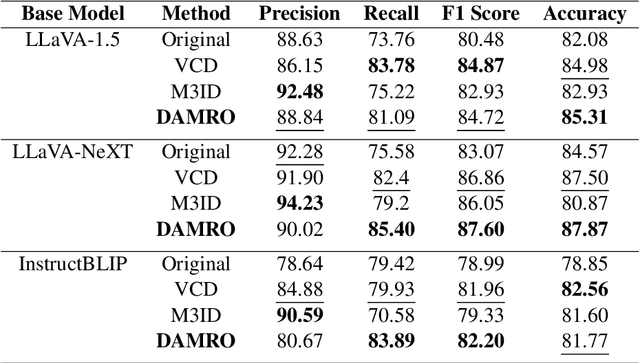
Abstract:Despite the great success of Large Vision-Language Models (LVLMs), they inevitably suffer from hallucination. As we know, both the visual encoder and the Large Language Model (LLM) decoder in LVLMs are Transformer-based, allowing the model to extract visual information and generate text outputs via attention mechanisms. We find that the attention distribution of LLM decoder on image tokens is highly consistent with the visual encoder and both distributions tend to focus on particular background tokens rather than the referred objects in the image. We attribute to the unexpected attention distribution to an inherent flaw in the visual encoder itself, which misguides LLMs to over emphasize the redundant information and generate object hallucination. To address the issue, we propose DAMRO, a novel training-free strategy that $D$ive into $A$ttention $M$echanism of LVLM to $R$educe $O$bject Hallucination. Specifically, our approach employs classification token (CLS) of ViT to filter out high-attention outlier tokens scattered in the background and then eliminate their influence during decoding stage. We evaluate our method on LVLMs including LLaVA-1.5, LLaVA-NeXT and InstructBLIP, using various benchmarks such as POPE, CHAIR, MME and GPT-4V Aided Evaluation. The results demonstrate that our approach significantly reduces the impact of these outlier tokens, thus effectively alleviating the hallucination of LVLMs. The code of our method will be released soon.
Raising the Bar: Investigating the Values of Large Language Models via Generative Evolving Testing
Jun 20, 2024



Abstract:Warning: this paper contains model outputs exhibiting unethical information. Large Language Models (LLMs) have achieved significant breakthroughs, but their generated unethical content poses potential risks. Measuring value alignment of LLMs becomes crucial for their regulation and responsible deployment. Numerous datasets have been constructed to assess social bias, toxicity, and ethics in LLMs, but they suffer from evaluation chronoeffect, that is, as models rapidly evolve, existing data becomes leaked or undemanding, overestimating ever-developing LLMs. To tackle this problem, we propose GETA, a novel generative evolving testing approach that dynamically probes the underlying moral baselines of LLMs. Distinct from previous adaptive testing methods that rely on static datasets with limited difficulty, GETA incorporates an iteratively-updated item generator which infers each LLM's moral boundaries and generates difficulty-tailored testing items, accurately reflecting the true alignment extent. This process theoretically learns a joint distribution of item and model response, with item difficulty and value conformity as latent variables, where the generator co-evolves with the LLM, addressing chronoeffect. We evaluate various popular LLMs with diverse capabilities and demonstrate that GETA can create difficulty-matching testing items and more accurately assess LLMs' values, better consistent with their performance on unseen OOD and i.i.d. items, laying the groundwork for future evaluation paradigms.
DESTEIN: Navigating Detoxification of Language Models via Universal Steering Pairs and Head-wise Activation Fusion
Apr 16, 2024Abstract:Despite the remarkable achievements of language models (LMs) across a broad spectrum of tasks, their propensity for generating toxic outputs remains a prevalent concern. Current solutions involving fine-tuning or auxiliary models usually require extensive memory and computational resources, rendering them less practical for deployment in large language models (LLMs). In this paper, we propose DeStein, a novel method that detoxififies LMs by altering their internal representations in the activation space with lower resource and time cost. Specifically, we leverage self-induced steering pairs to identify detoxification vectors through arithmetic operations in the activation space. During inference, detoxification is achieved by blending the detoxification vectors with the original representations. Empirical results demonstrate that our method significantly outperforms previous state-of-the-art approaches on popular detoxification metrics, while also maintaining satisfactory generation quality and diversity. Furthermore, we extend our method to multiple LLMs, demonstrating its practicality and scalability. Warning: some example model outputs contain highly offensive or disturbing text.
On the Essence and Prospect: An Investigation of Alignment Approaches for Big Models
Mar 07, 2024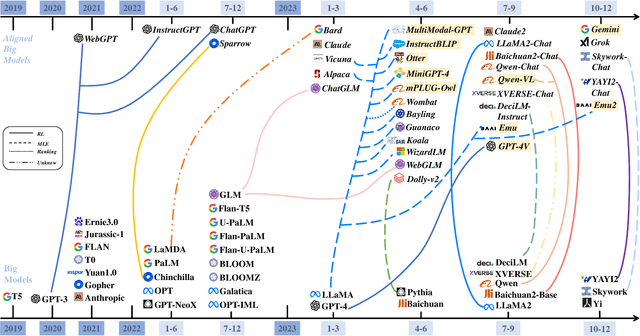
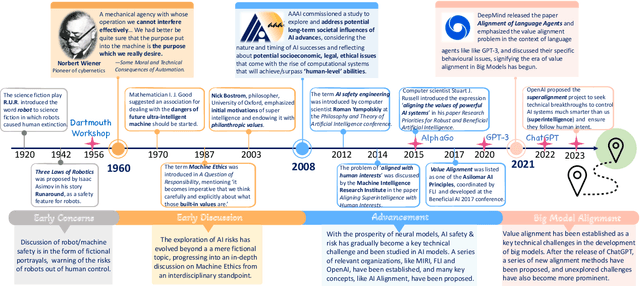
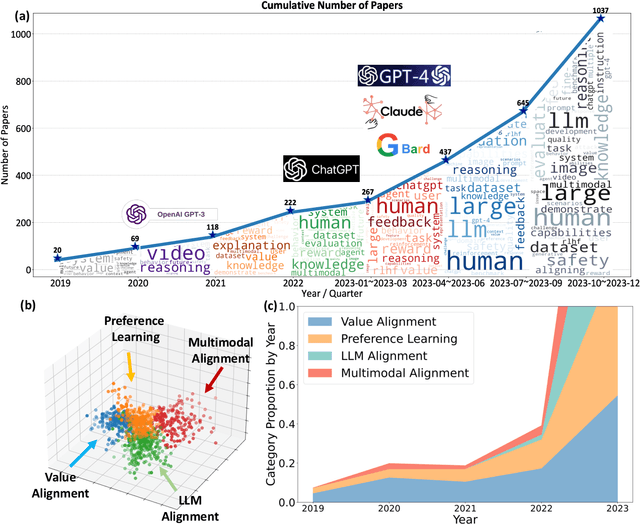
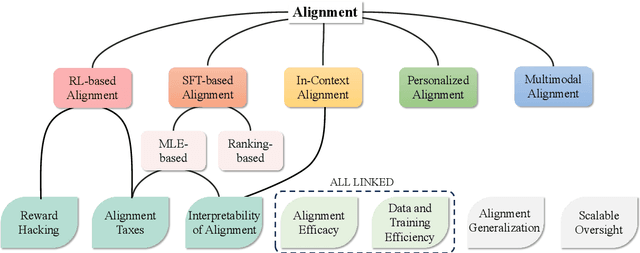
Abstract:Big models have achieved revolutionary breakthroughs in the field of AI, but they might also pose potential concerns. Addressing such concerns, alignment technologies were introduced to make these models conform to human preferences and values. Despite considerable advancements in the past year, various challenges lie in establishing the optimal alignment strategy, such as data cost and scalable oversight, and how to align remains an open question. In this survey paper, we comprehensively investigate value alignment approaches. We first unpack the historical context of alignment tracing back to the 1920s (where it comes from), then delve into the mathematical essence of alignment (what it is), shedding light on the inherent challenges. Following this foundation, we provide a detailed examination of existing alignment methods, which fall into three categories: Reinforcement Learning, Supervised Fine-Tuning, and In-context Learning, and demonstrate their intrinsic connections, strengths, and limitations, helping readers better understand this research area. In addition, two emerging topics, personal alignment, and multimodal alignment, are also discussed as novel frontiers in this field. Looking forward, we discuss potential alignment paradigms and how they could handle remaining challenges, prospecting where future alignment will go.
 Add to Chrome
Add to Chrome Add to Firefox
Add to Firefox Add to Edge
Add to Edge